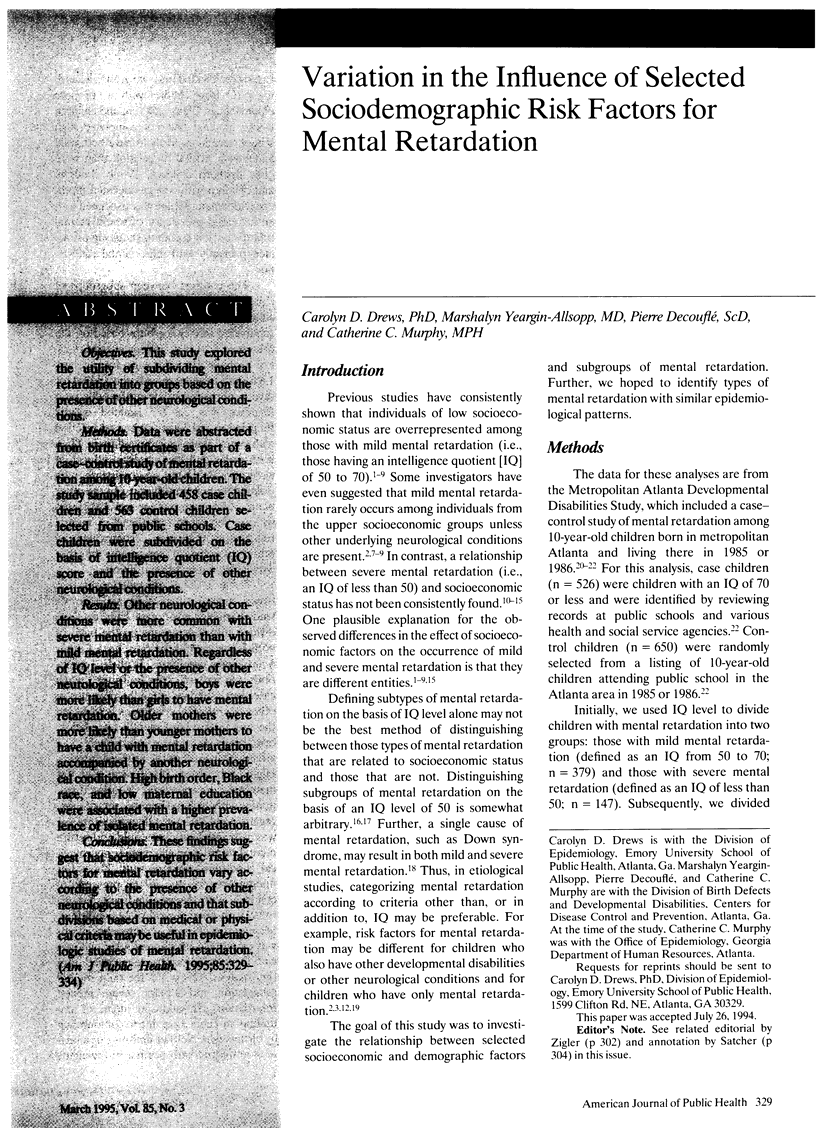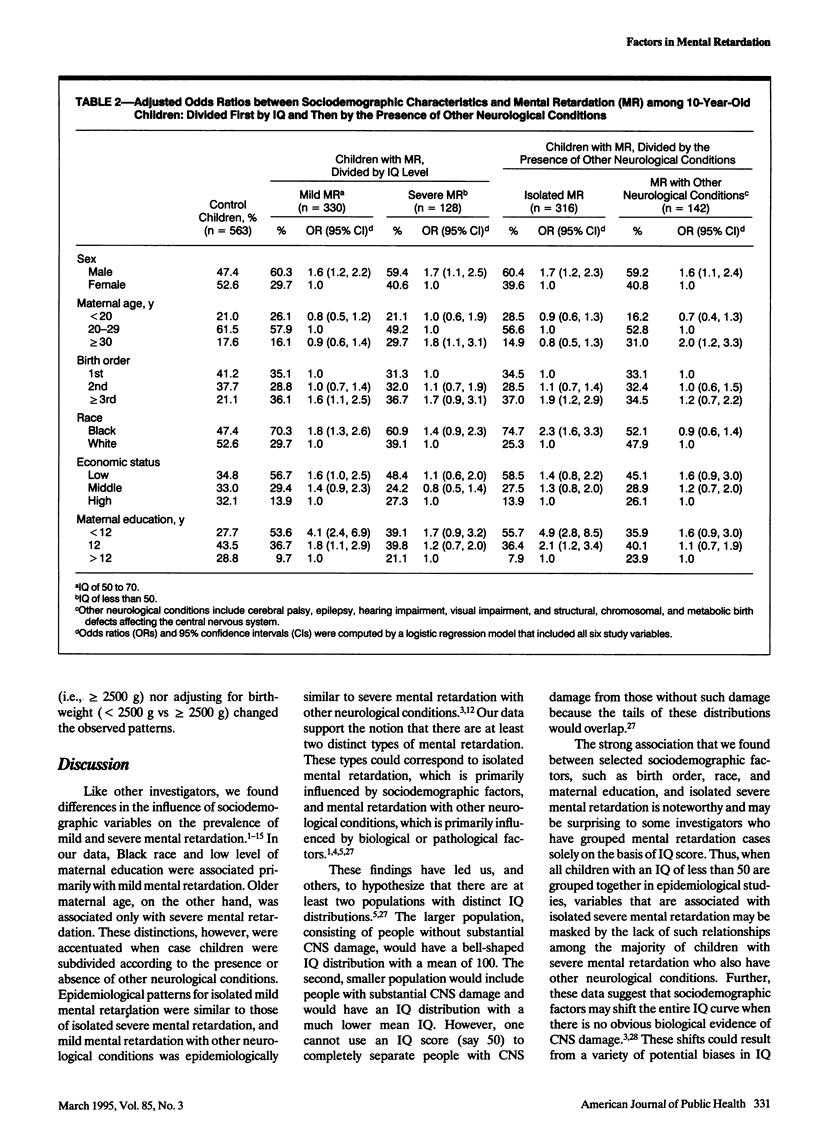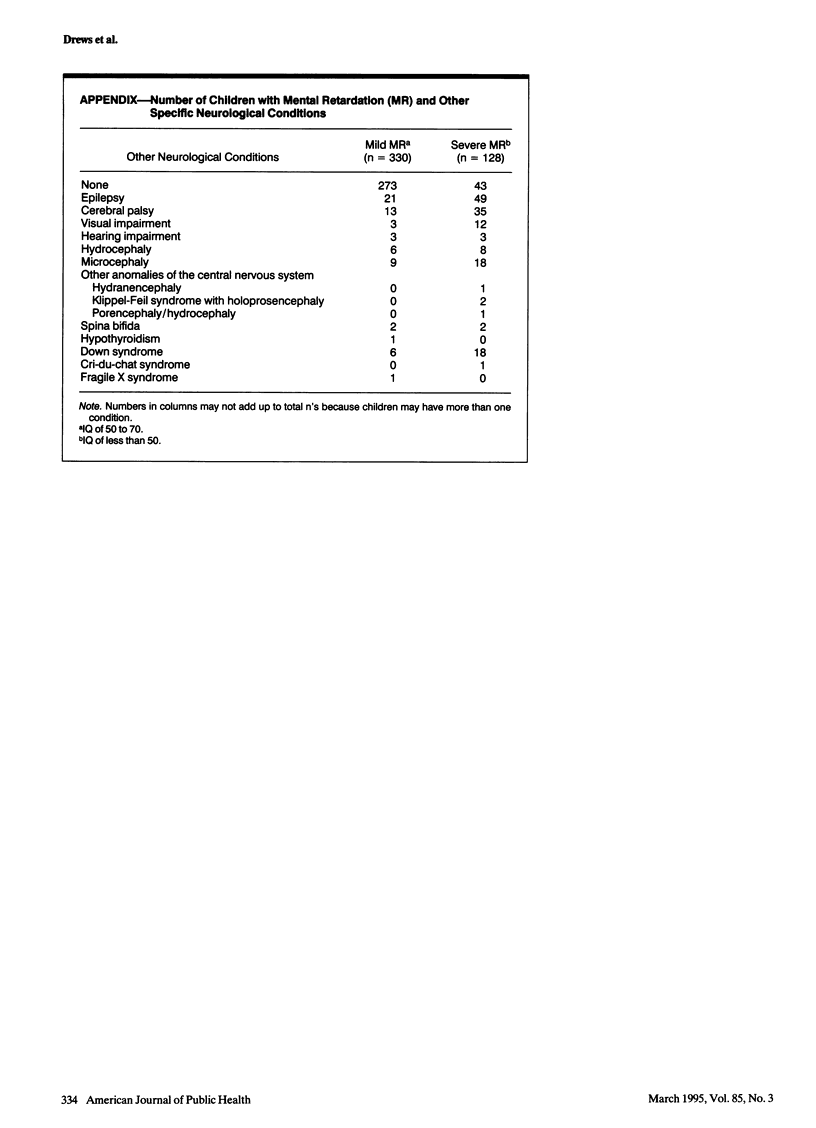Abstract
OBJECTIVES. This study explored the utility of subdividing mental retardation into groups based on the presence of other neurological conditions. METHODS. Data were abstracted from birth certificates as part of a case-control study of mental retardation among 10-year-old children. The study sample included 458 case children and 563 control children selected from public schools. Case children were subdivided on the basis of intelligence quotient (IQ) score and the presence of other neurological conditions. RESULTS. Other neurological conditions were more common with severe mental retardation than with mild mental retardation. Regardless of IQ level or the presence of other neurological conditions, boys were more likely than girls to have mental retardation. Older mothers were more likely than younger mothers to have a child with mental retardation accompanied by another neurological condition. High birth order, Black race, and low maternal education were associated with a higher prevalence of isolated mental retardation. CONCLUSIONS. These findings suggest that sociodemographic risk factors for mental retardation vary according to the presence of other neurological conditions and that subdivisions based on medical or physical criteria may be useful in epidemiologic studies of mental retardation.
Full text
PDF





Selected References
These references are in PubMed. This may not be the complete list of references from this article.
- Abramowicz H. K., Richardson S. A. Epidemiology of severe mental retardation in children: community studies. Am J Ment Defic. 1975 Jul;80(1):18–39. [PubMed] [Google Scholar]
- Baird P. A., Sadovnick A. D. Mental retardation in over half-a-million consecutive livebirths: an epidemiological study. Am J Ment Defic. 1985 Jan;89(4):323–330. [PubMed] [Google Scholar]
- Cooper B., Lackus B. The social-class background of mentally retarded children. A study in Mannheim. Soc Psychiatry. 1984;19(1):3–12. doi: 10.1007/BF00583856. [DOI] [PubMed] [Google Scholar]
- Drillien C. M., Jameson S., Wilkinson E. M. Studies in mental handicap. I. Prevalence and distribution by clinical type and severity of defect. Arch Dis Child. 1966 Oct;41(219):528–538. doi: 10.1136/adc.41.219.528. [DOI] [PMC free article] [PubMed] [Google Scholar]
- Edmonds L. D., Layde P. M., James L. M., Flynt J. W., Erickson J. D., Oakley G. P., Jr Congenital malformations surveillance: two American systems. Int J Epidemiol. 1981 Sep;10(3):247–252. doi: 10.1093/ije/10.3.247. [DOI] [PubMed] [Google Scholar]
- Herbst D. S., Miller J. R. Nonspecific X-linked mental retardation II: the frequency in British Columbia. Am J Med Genet. 1980;7(4):461–469. doi: 10.1002/ajmg.1320070407. [DOI] [PubMed] [Google Scholar]
- Innes G., Kidd C., Ross H. S. Mental subnormality in North-East Scotland. Br J Psychiatry. 1968 Jan;114(506):35–41. doi: 10.1192/bjp.114.506.35. [DOI] [PubMed] [Google Scholar]
- Kiely M. The prevalence of mental retardation. Epidemiol Rev. 1987;9:194–218. doi: 10.1093/oxfordjournals.epirev.a036302. [DOI] [PubMed] [Google Scholar]
- McLaren J., Bryson S. E. Review of recent epidemiological studies of mental retardation: prevalence, associated disorders, and etiology. Am J Ment Retard. 1987 Nov;92(3):243–254. [PubMed] [Google Scholar]
- Munro J. D. Epidemiology and the extent of mental retardation. Psychiatr Clin North Am. 1986 Dec;9(4):591–624. [PubMed] [Google Scholar]
- Murphy C. C., Yeargin-Allsopp M., Decouflé P., Drews C. D. The administrative prevalence of mental retardation in 10-year-old children in metropolitan Atlanta, 1985 through 1987. Am J Public Health. 1995 Mar;85(3):319–323. doi: 10.2105/ajph.85.3.319. [DOI] [PMC free article] [PubMed] [Google Scholar]
- Rantakallio P. Social class differences in mental retardation and subnormality. Scand J Soc Med. 1987;15(2):63–66. doi: 10.1177/140349488701500202. [DOI] [PubMed] [Google Scholar]
- Richardson S. A., Katz M., Koller H. Sex differences in number of children administratively classified as mildly mentally retarded: an epidemiological review. Am J Ment Defic. 1986 Nov;91(3):250–256. [PubMed] [Google Scholar]
- Robinson R. O. Associated handicap and mild mental retardation. Ups J Med Sci Suppl. 1987;44:99–102. [PubMed] [Google Scholar]
- STEIN Z., SUSSER M. The families of dull children. A classification for predicting careers. Br J Prev Soc Med. 1960 Apr;14:83–88. doi: 10.1136/jech.14.2.83. [DOI] [PMC free article] [PubMed] [Google Scholar]
- STEIN Z., SUSSER M. The social distribution of mental retardation. Am J Ment Defic. 1963 May;67:811–821. [PubMed] [Google Scholar]
- Yeargin-Allsopp M., Drews C. D., Decouflé P., Murphy C. C. Mild mental retardation in black and white children in metropolitan Atlanta: a case-control study. Am J Public Health. 1995 Mar;85(3):324–328. doi: 10.2105/ajph.85.3.324. [DOI] [PMC free article] [PubMed] [Google Scholar]
- Yeargin-Allsopp M., Murphy C. C., Oakley G. P., Sikes R. K. A multiple-source method for studying the prevalence of developmental disabilities in children: the Metropolitan Atlanta Developmental Disabilities Study. Pediatrics. 1992 Apr;89(4 Pt 1):624–630. [PubMed] [Google Scholar]
- Zigler E. Familial mental retardation: a continuing dilemma. Science. 1967 Jan 20;155(3760):292–298. doi: 10.1126/science.155.3760.292. [DOI] [PubMed] [Google Scholar]


